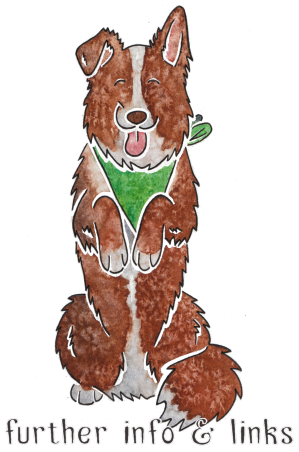

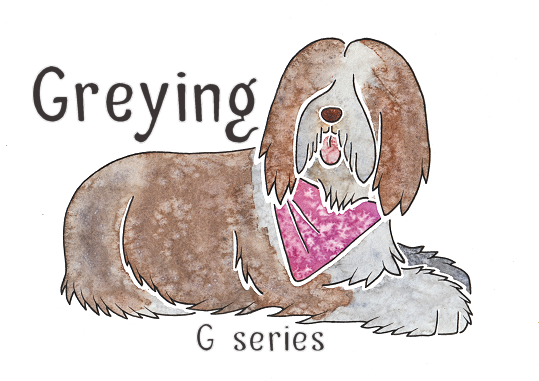

Already know what you're looking for? Quick Links | |
The Greying Gene
The greying gene occurs on the G locus. It's thought to be an incomplete dominant, so G is greying and g is non-greying, and in order for
a dog to express greying it only needs to have one copy of G (so its genotype can be Gg or GG). GG will generally have a stronger effect on the coat than Gg. A dog that doesn't express the greying
gene has the genotype gg. Greying is expressed on long, curly and wire-haired coats only, so a short-haired dog may have the gene but show no sign of it.
The greying gene, like dilution, affects eumelanin (black and liver). However, unlike the dilution gene it doesn't actually affect the
nose or eye colour, it is progressive (so a dog with greying is born solid black or liver and becomes lighter as it gets older), and it doesn't always
affect the whole of the coat to the same extent (the shade of grey in different parts may vary, and some parts may even remain black). A dog with the dilution
gene may have greying as well, but it's rare for the two genes to occur in the same breed.
Greying doesn't affect phaeomelanin (red) to the same extent. Sometimes breeds which have the greying gene also come in shades of cream, which suggests
that the lightening of the two types of pigment is connected. However, as the rich tan on some Yorkshire Terriers proves, there is not necessarily a strong connection. Red is generally lightened by the intensity (I) series, and some breeds
simply carry both greying and phaeomelanin dilution.
One last interesting thing to note about greying is that while it affects dogs with tan markings (saddles, traditional tan etc) it does not always affect masks. Kerry Blues are a striking example of this -
their main coat may turn to silver while leaving the hair on their muzzle solid black. It's not known why this happens, but it could be that E-locus black (such as masks) just isn't affected in the same way by greying as K- or A-locus black.
Breeds With the Greying Gene
The greying gene occurs in a small number of breeds, the most notable of which are:
Old English Sheepdog
As you can see by this list, greying is found almost solely in long-haired breeds. This is probably because the hair lightens as it grows,
so on a short-haired dog the hair doesn't get long enough to start greying before it's shed and a new hair starts to grow. Some short-haired breeds may well have the greying gene
but it's just not visible. Greying seems to be particularly prominent on non-shedding breeds such as the Poodle and the Kerry Blue, presumably because each hair, if it's not shed, has much longer to
turn grey.
In technical terms, we can hypothesise that the greying gene causes the eumelanin pigment in the hair to break up and degrade more easily (probably through structural faults in the proteins making up the pigment). This means that the hair simply
doesn't "hold" pigment in the same way that it would normally do. Any new hairs that begin to grow (for example, if the dog is shaved down) are the normal colour and the hairs then lose the colour as they grow and age.
Because greying is dominant, it appears regularly in mixed breeds (as only one parent needs to have the gene), particularly in the UK where
Bearded Collie crosses are common, as well as various terrier crosses.
Examples of Greying
Dogs with greying may take years to turn from black to grey. This Bedlington Terrier shows the progression of grey as a dog ages, from birth to 16 months. Notice
how the shortest areas of the coat (tail and ears) are the darkest, followed by the body, and the longest parts of the coat (leg furnishings
and topknot) are the lightest.
Kai here demonstrates greying on a sable. Sables are often born very dark, as you can see in the first photo where newborn Kai looks almost black. By the final photo his black has turned completely to grey.
Four dogs showing the different extents of greying, from light (left) to dark (right). It's possible that the dark dogs are gg, the medium dogs are Gg and the light dogs are GG. Of course, the lightness of the coat can also be affected by
the coat length and type (the non-shedding Bedlington, above, may end up almost white but the shedding Wolfhounds and Deerhound above will probably not get any lighter than in these photos).
Premature Greying
This is another form of greying that does not currently have a known genetic basis. Usually a dog's muzzle and face will grey with age, but in some dogs this occurs early (before the dog is 5). This appears to happen most often on dogs with masks. The Papillon above shows
normal age-related greying, and the Great Dane shows premature greying.
Further Info and Links
The gene causing greying has not yet been located, although work has begun in locating a similar gene in horses, which may eventually shed some light on dog greying. This section will be updated if/when more information is discovered.
** Please note that I am not a research scientist, and the information on this page comes from my own knowledge and observation of dogs, observational and testing data provided via e-mail by site visitors, any research papers linked on the page, and the information provided by Dr Sheila M. Schmutz on her excellent website http://homepage.usask.ca/~schmutz/dogcolors.html
For further genetics resources, see the Links page


Bearded Collie
Tibetan Terrier
Polish Lowland Sheepdog
Bedlington Terrier
Dandie Dinmont Terrier
Basset Griffon Vendeen (Grand and Petit)
Poodle (Standard, Miniature and Toy)
Irish Wolfhound
Deerhound
Cesky Terrier
Kerry Blue Terrier
Havanese
Glen of Imaal Terrier

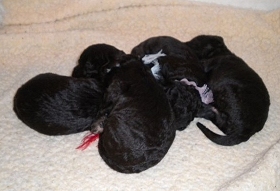
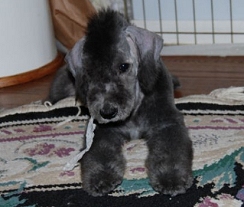
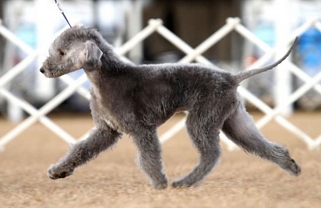
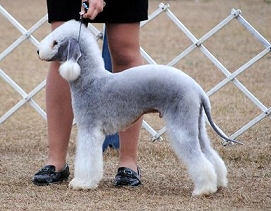
Bedlington Terrier BISS GCh LAMZ Heads I Win Tails You Lose, photos provided by Gaby

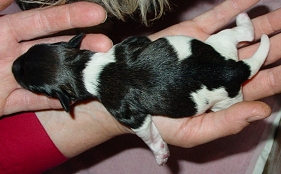

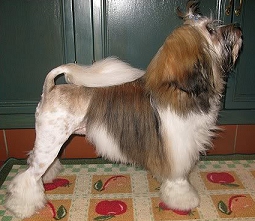
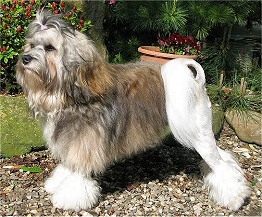
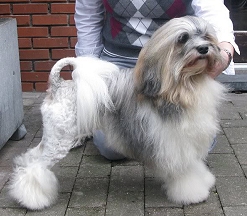
Lowchen Belgian Ch Kai de la Maison Dominique, photos provided by Linsey

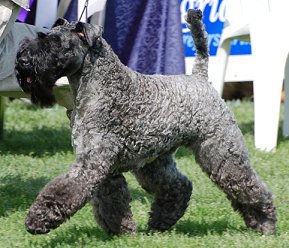
This Kerry Blue Terrier has very lightly-coloured body fur, but its muzzle is still black. This is because it has a black mask (Em). This photo
was taken by June.

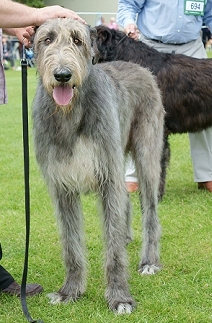
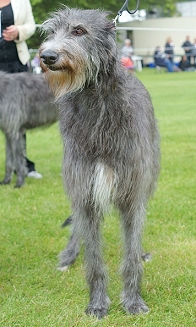
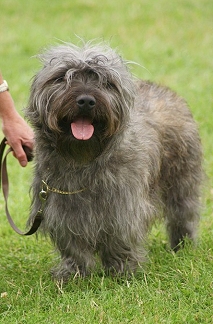
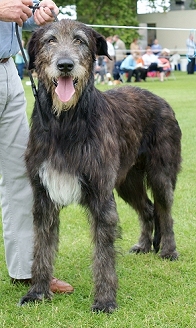

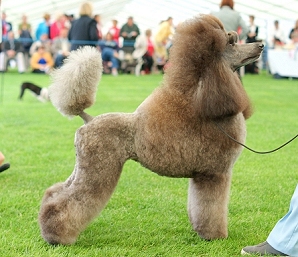
The Standard Poodle shown here has very uneven greying on a liver (bb) coat.
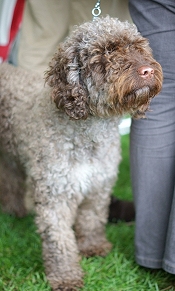
This is another liver dog with greying. The dark pigment around the muzzle is possibly a mask, which would not usually show up on a solid liver dog but in this case has not greyed like the rest of the coat.
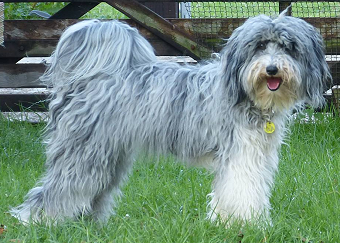
Greying can hide merle markings, as this photo of Angel, submitted by Natalie Lagstrom, shows. Angel is an Australian Shepherd cross, and her merle markings just appear as different shades of grey in her long coat. If she was shaved down, her markings would become obvious again.

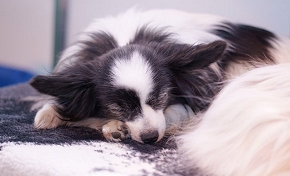
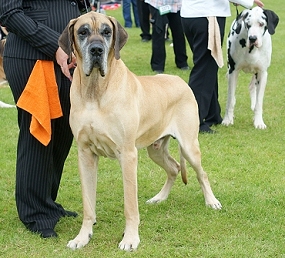

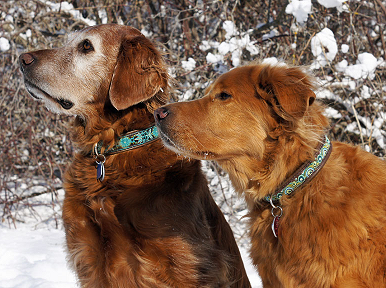
In this photo, Casey the Golden Retriever (left) is 9 years old and Nala the mixed breed (right) is 11. Both dogs have the same coat pattern (recessive red), and yet the younger dog is the one who has greyed. The greying appears to follow the pattern of a mask. Photos submitted by Jamie Elvert.

